Ssms Not Dispaying Line Feed in Result Window
SSMSBoost add-in for SQL Server Management Studio
Microsoft SQL Server is shipped with powerful, stable and predictable working environment - SSMS. So, why invent new editors and environments ?
SSMSBoost enhances SQL Server Management Studio and adds features like export to excel, results grid search, sessions history, destructive DML guard and many other. The main goal of the project is to speed-up your daily tasks as DBA, SQL developer or data miner, additionally protecting you from occasional data or code loss.
Shortly after the installation you will realize that plug-in saves you hundreds of mouse-clicks and key strokes every day !
SQL Server Management Studio versions supported: 2008, 2008/R2, 2012, 2014, 2016, 2017, 2018
Licensing options: after 30 day trial period register and get free community license or buy the professional version.
Versions comparison page gives you a short overview about the differences between both versions.
SSMSBoost was released to the public in 2012 and was adopted since then by more than 40 000 registered users from more than 15 000 companies around the world. Just to mention some of them:

Features, added by SSMSBoost to SQL Server Management Studio
Preferred connections: "remember" favorite servers/databases
This functionality may be very convenient for those who have to deal with several servers on a daily basis. Preferred connections allow you to remember your favorite servers/databases and pre-configure several connection settings.
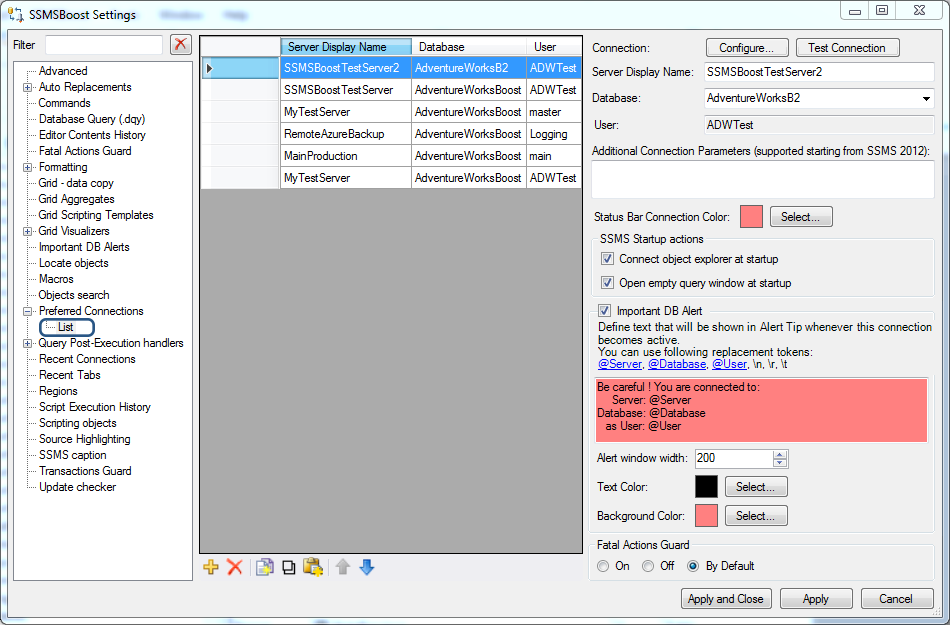
Following options can be configured under SSMSBoost ->Settings->Preferred connections->List:
- Connection alias
Server names are often too long and difficult to percept, memorize and operate (like customerserver823127.hosteddomainsample.com). To fix this inconvenience SSMSBoost added the possibility of defining user friendly Server Display Names to the original server names:
customerserver823127.hosteddomainsample.com -> DEVELOPMENT
customerserver823555.hosteddomainsample.com -> PRODUCTION - Additional Connection Parameters Sometimes you need to specify additional parameters to establish connection with a server. SSMS basiс functionality does not provide space for the storage of these parameters forcing you to enter strings manually every time you connect to your server. SSMSBoost allows you to predefine and save Additional Connection Parameters once and for all.
- Connect Object Explorer at StartupChoose this parameter if you need SSMS to automatically start with Object Explorer connected
- Open empty query window at Startup
Choose this parameter if you need SSMS to automatically start with an empty query window opened
- Status Bar Connection Color
Color coding is a very effective method that improves and speeds up the perception of visual information. SSMSBoost adds this feature to help you rapidly distinguish between development (e.g. green) and production databases (e.g. red). Any RGB color can be chosen. If you define color for a preferred connection where no database is specified this color will be applied whenever any database from that server is active. SSMSBoost tracks connection changes and selects the relevant color on every reconnection.
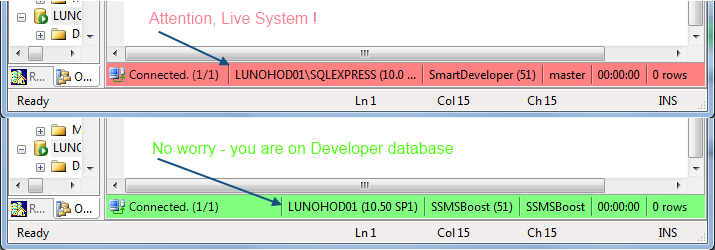
- Important DB Alert
This feature uses the same color coding method and protects you from occasional data modifications in production environments. As soon as you change connection to the database for which this option is enabled a warning message will appear.
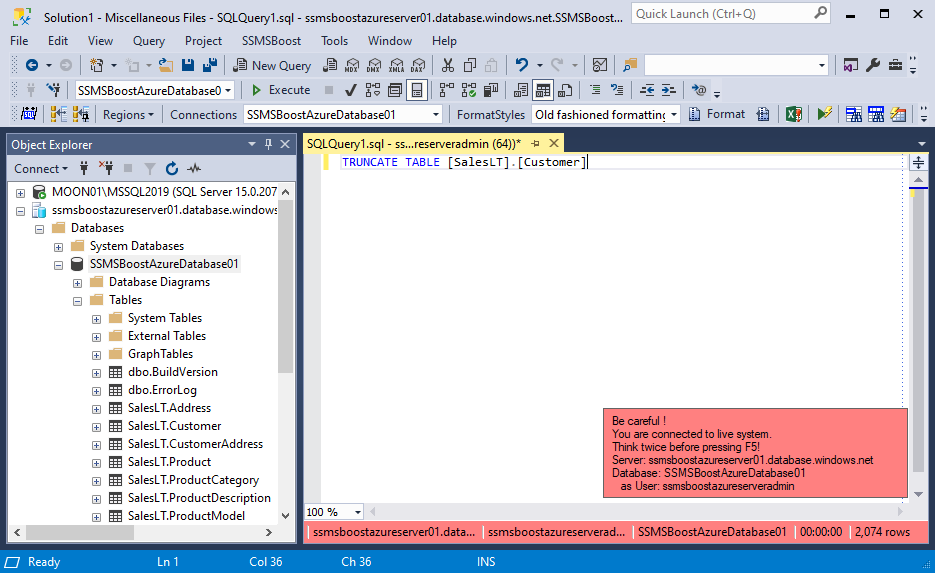
Text, color, width and the position of the warning message are fully customizable, you can use the following replacement tokens: {@Server}, {@Database}, {@User}, \r, \n, \t.
To configure message position go to SSMSBoost -> Settings -> Important DB Alerts. - Fatal Actions Guard Mode
Fatal Actions Guard is an SSMSBoost security tool that parses scripts executed in SSMS and checks for potentially dangerous statements. You can configure Fatal Actions Guard mode individually for each preferred connection
For your convenience we have also provided the possibility of adding databases displayed in Object Explorer to Preferred Connections by right-clicking on the node and selecting "Add to preferred connections":
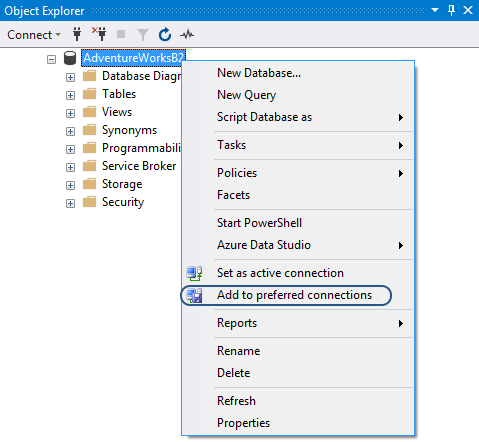
The list of your Preferred Connections will be displayed on the main toolbar in Quick connection switch drop-down that allows you to switch between connections instantly.
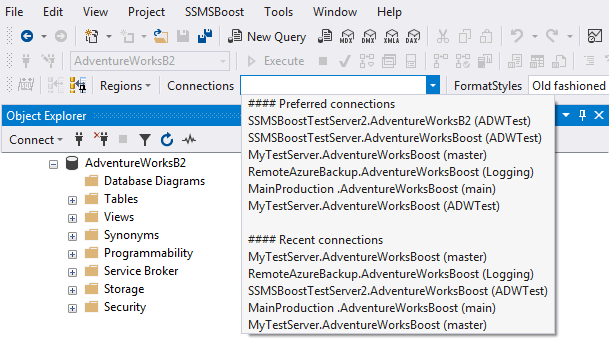
The order in Quick Connections Switch drop-down and the maximum number of recent connections can be configured at SSMSBoost->Settings->Preferred Connections
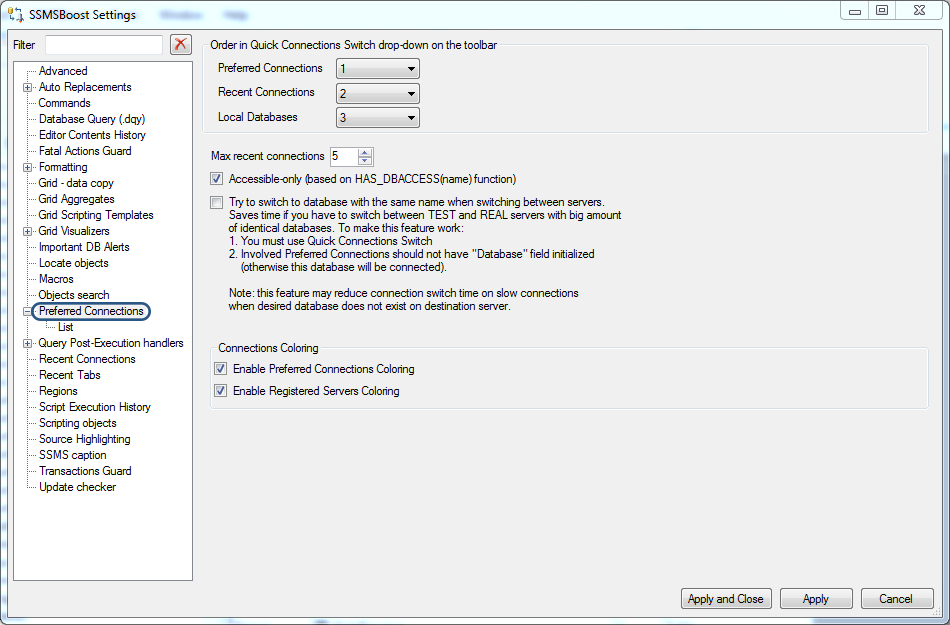
Note, that in Free Community Edition the number of preferred connections is limited to 2.
Quick Connection Switch
Quick Connection Switch drop-down on the toolbar combines three useful features originally missing in SSMS:
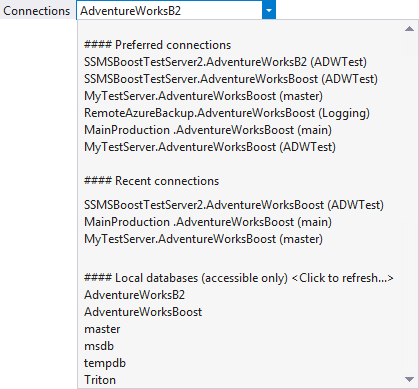
- Allows switching between Preferred connections
- Keeps track of Recent connections
- Shows all or ACCESSIBLE-only local databases
If SSMS starts with an empty environment you can choose any connection from Quick Connection Switch drop-down to create an empty document with an appropriate connection.
To perform fine-tuning of Quick Connection Switch drop-down go to SSMSBoost -> Settings-> Preferred Connections
Connection Coloring
Native SQL Server Management Studio connection dialog allows you to choose the color of the status bar when initiating a new database connection. However, this color remains the same for all connections. SSMSBoost solves this problem: you can specify an appropriate color for SERVER or SERVER/DATABASE when adding a Preferred Connection:
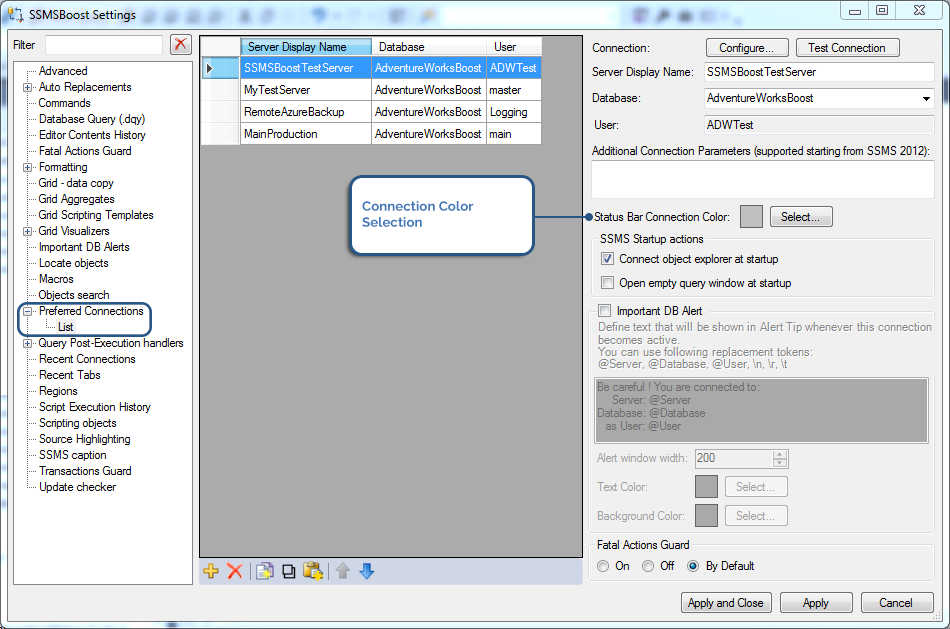
SSMSBoost tracks connection changes in real time and applies the matching color to the status bar. The most common color choice is "Red" for your live system status bar and "Green" for your test database status bar.

Important Database alert
This feature should be used for very important connections in addition to Connection coloring. When adding a Preferred Connection tick "Important DB Alert" checkbox, then specify alert message and color.
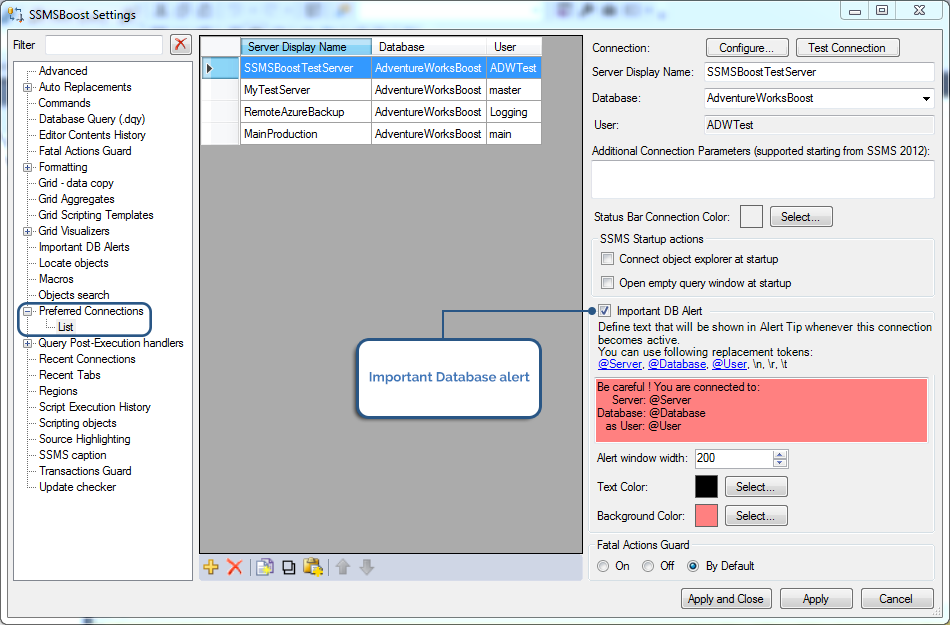
Whenever a current connection changes to this particular connection a floating pop-up will remind you that you are working with an important database.
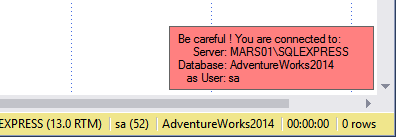
Auto-connect Object Explorer to databases at startup
If this function is enabled SSMS will start with Object Explorer connected to your preferred databases. To use this option go to:
SSMSBoost => Settings => Preferred Connections => List
Select the database connection that you want Object Explorer to automatically initialize at startup, click "Connect object explorer at startup" and press "Apply" button.
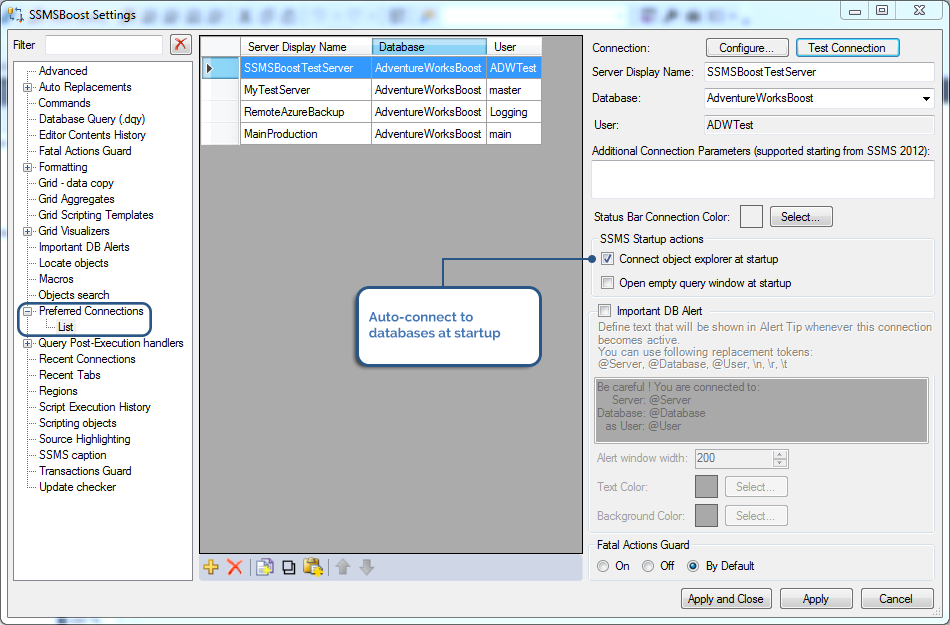
Auto-open new query window(s) at startup
If this function is enabled SSMSBoost will create empty query windows connected to your favorite databases at startup. To use this option go to:
SSMSBoost => Settings => Preferred Connections => List
Select the database connection on which you want SSMSBoost to create an empty query window, click "Open empty query window at startup" and press "Apply" button.
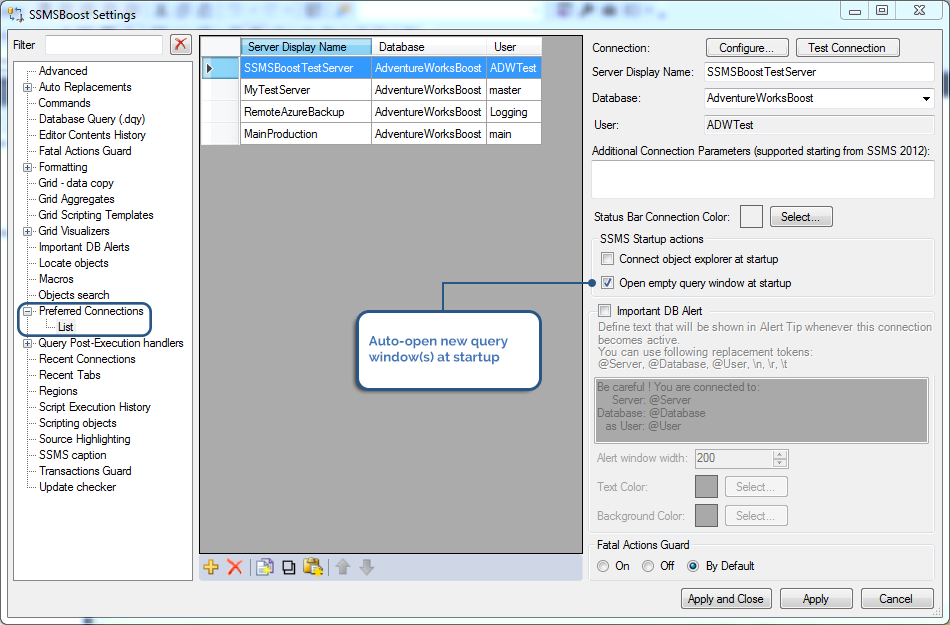
Set Connection from Object Explorer
If you need to switch connection of the current SQL Editor window to any database displayed in Object Explorer - right-click it in Object Explorer and choose ![]() Set as active connection:
Set as active connection:
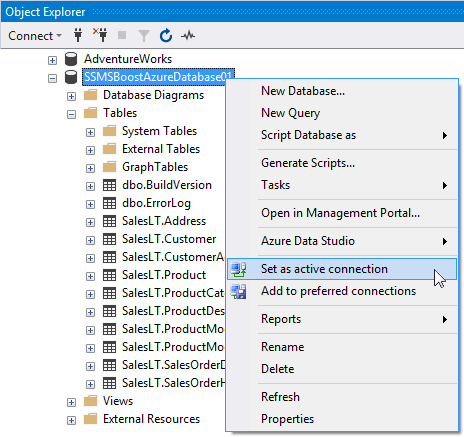
Copy full object name from Object Explorer
This function allows you to copy full object name in Object Explorer. Right click the object and select "Copy Full Name To Clipboard" - SSMSBoost will copy object's full name to clipboard (including database and schema).
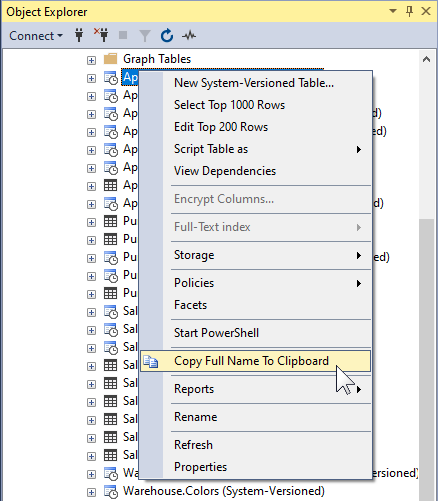
Script Object from SQL Editor: "Go To Definition" for SQL Objects
Script object located at cursor position directly from SQL Editor.
Keyboard Shortcut: [F2]
 SQL Server Management Studio currently lacks the feature present in other Visual Studio Editors - "Go to definition".
SQL Server Management Studio currently lacks the feature present in other Visual Studio Editors - "Go to definition".
SSMSBoost add-in solves this problem by adding the tool that you need: Script Object located at the cursor position to a new window.
You can invoke this feature by:
- pressing Keyboard Shortcut [F2]
- right-clicking the identifier and selecting "Script object as CREATE" or "Script object as ALTER" from the context menu
SSMSBoost performs the search for valid identifiers at cursor location and allows you to select the one you want to script. If you select a part of an identifier - SSMSBoost will perform no search and will use the selected text as object identifier.
If you would like to change the default Keyboard Shortcut for the "Script Object" feature you can do that using Shortcuts Editor feature at SSMSBoost->Settings->Commands.
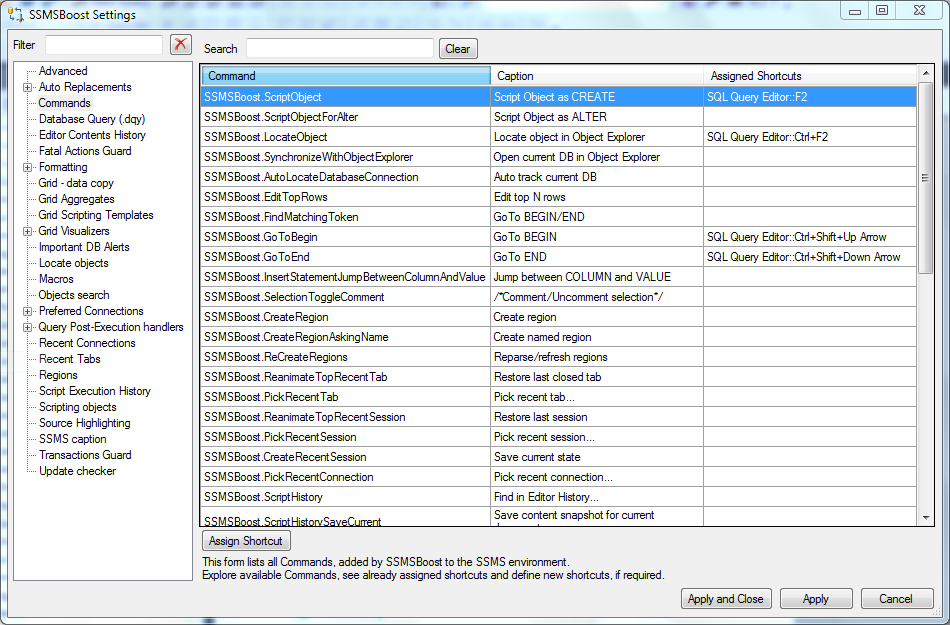
Additional Scripting options for SQL objects scripting
SSMS doesn't show all scripting options by default. For SSMSBoost operations we provide you with all internal scripting options structure available in SSMS. Be careful - some of them might not work, some of them can stop scripting option from working. For experts use only!
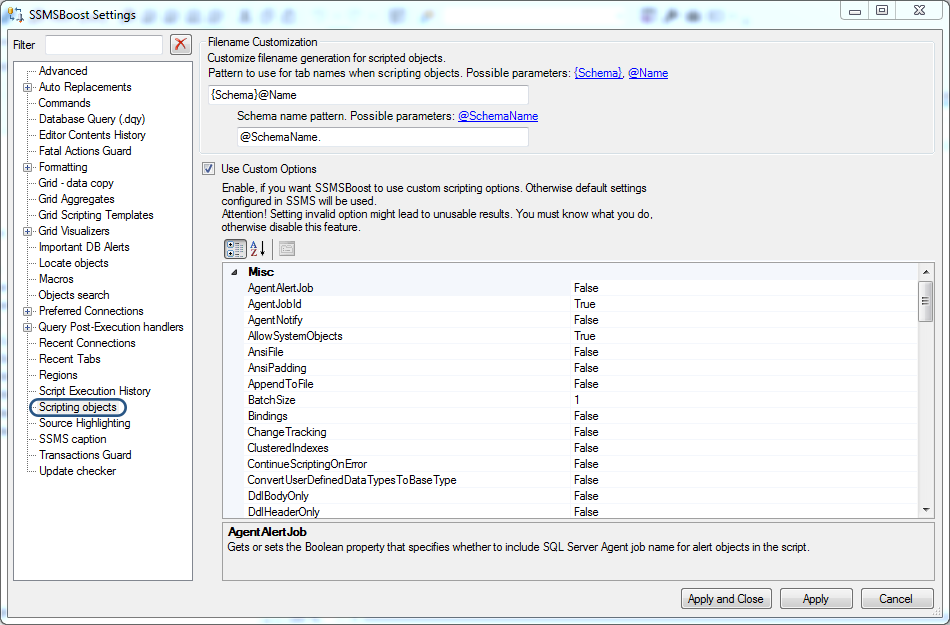
Edit Top N Table Rows
SQL Server Management Studio allows you to right-click a table in Object Explorer and select "Edit top N rows". With SSMSBoost you can do the same by right-clicking a table name directly in SQL Editor.
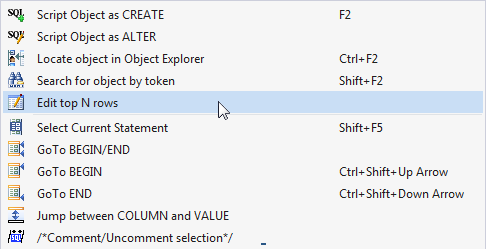
The number of top rows can be customized in SSMS settings: Tools =>Options => SQL Server Objects Explorer =>Commands =>Table and View Options
Locate Object in Object Explorer focused in SQL Editor
This function locates an object in Object Explorer directly from SQL Editor.
When working with databases, you often need a more detailed information about an object under the cursor: its columns, parameters (for function or procedure) and other properties. If a database has hundreds of objects locating an object in Object Explorer can take some time. SSMSBoost allows you to locate an object in seconds!
To use this function place the cursor on the identifier and press CTRL+F2 or select "Locate object in Object Explorer" in context menu:
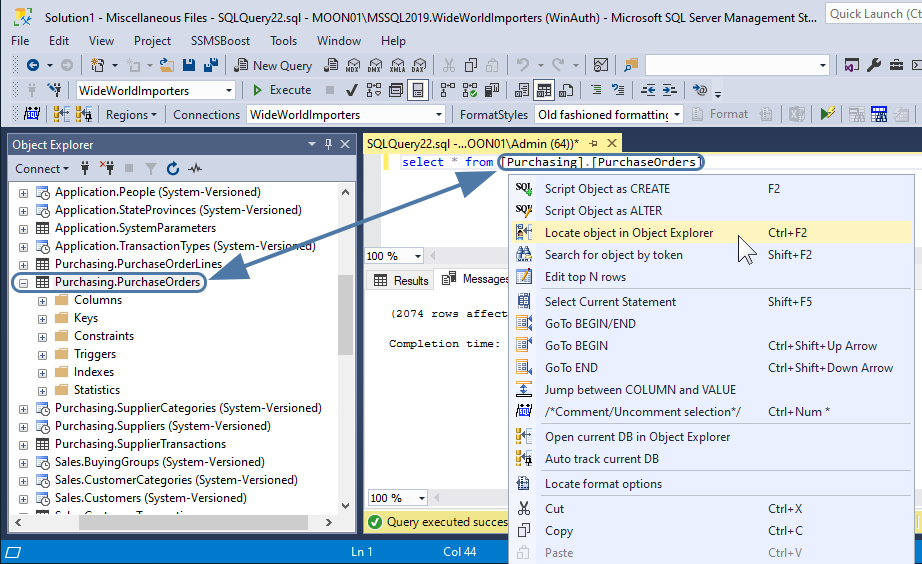
SSMSBoost searches for valid identifiers at cursor location and allows you to select the one you want to locate. If you select a part of the identifier SSMSBoost performs no search and uses the selected text as object identifier.
As soon as you press CTRL+F2 or click "Locate object in Object Explorer" in context menu the object is quickly found in the database and highlighted in Object Explorer with its node expanded so that you can easily access its properties and, for example, drag-n-drop parameters of the stored procedure into SQL Editor window.
If you want to change the default Keyboard Shortcut of "Locate Object" feature you can do that by using another SSMSBoost feature - Shortcuts editor (needed only in SSMS 2008, as far as SSMS 2012 and later versions have built-in shortcuts editor)
Track current database
When you work with multiple opened scripts connected to different servers and databases, the option of instant location of the current database in Object Explorer might be very useful.
SSMSBoost gives you this possibility - just hit ![]() on SSMSBoost toolbar and the current Server/Database will be focused in Object Explorer.
on SSMSBoost toolbar and the current Server/Database will be focused in Object Explorer.

The left button is responsible for a single-time action while the ![]() button allows you to always focus on the current database whenever you change the connection of your script or switch between scripts.
button allows you to always focus on the current database whenever you change the connection of your script or switch between scripts.

This function is similar to "synchronize table of contents" in Windows Help or "synchronize solution explorer" in Visual Studio.
Autoreplacements
AutoReplacements or "snippets" allow you toinput frequently used SQL commands much faster. Type "sel" and press SPACE, ENTER or TAB (configurable in Settings) - and it will be replaced with "select * from". "upd" will be replaced with "update # set where". "#" defines where cursor will be placed after the replacement is done (this symbol is customizable with the help of AutoReplacement). SSMSBoost AutoReplacements improve similar SSMS basic functionality:
- Tokens can be case-sensitive
- It is possible to specify final cursor location, after AutoReplacement is triggered
- You can use standard SSMS parameters like <name, type, default value> in AutoReplacements. SSMSBoost detects these parameters and automatically shows Parameters replacement dialog saving you additional clicks/keystrokes.
- The following parameters can be used in AutoReplacements:{User}, {Server}, {Database}, {Connection}, {Timestamp} , {Timestamp:Format} (.Net datetime format). These parameters will be replaced with the actual information after AutoReplacement is triggered. For example you can create an AutoReplacement to place a Username/Timestamp comment into your source code.
You can easily add your own AutoReplacements.
Sample for "sel" token:
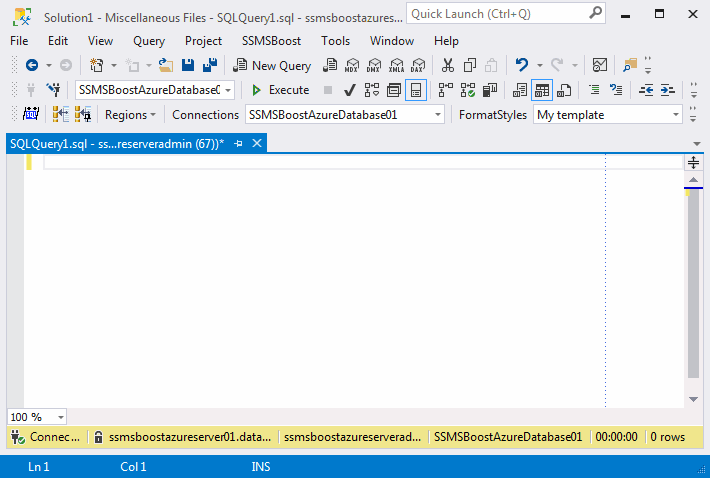
Sample for "upd" token:
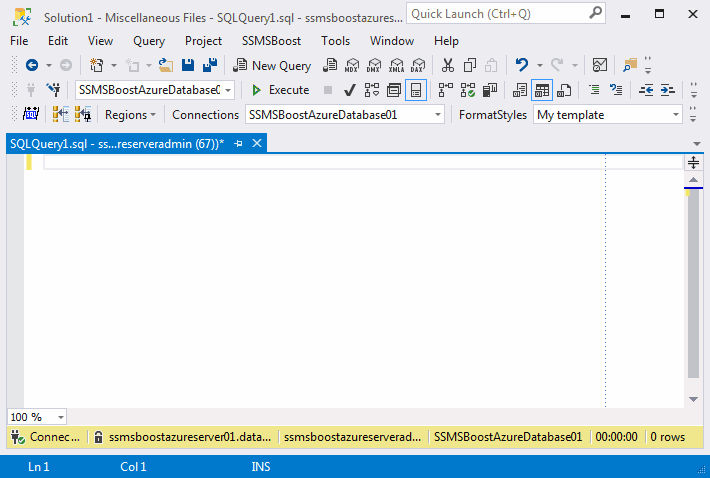
Custom SSMS window title (caption)
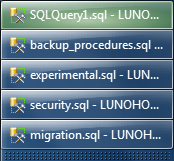 Originally SSMS displays static caption: "Microsoft SQL Server Management Studio". If you have several instances open and try to switch between them using Alt-Tab or task bar you will not be able to see the difference between instances. SSMSBoost makes it possible to redefine the caption of SSMS window so that you will be able to see current document name and connection information. You can also define your own pattern to be used as the window title.
Originally SSMS displays static caption: "Microsoft SQL Server Management Studio". If you have several instances open and try to switch between them using Alt-Tab or task bar you will not be able to see the difference between instances. SSMSBoost makes it possible to redefine the caption of SSMS window so that you will be able to see current document name and connection information. You can also define your own pattern to be used as the window title.
Available parameters are: @FileName, @Server, @Database, @User. Parameters can be used within the main pattern as well as in sub-patterns {ProjectName} and {Connection}. {ProjectName} pattern will be inserted only if SSMS project is loaded. {Connection} pattern will be inserted only if connection is open.
Picture on the right shows you how different SSMS instances are displayed on the task bar. Pictures below show how the caption of SSMS looks like and how windows appear in Aero Peek.

Aero Peek with modified SSMS caption

Advanced Objects Search
Advanced Objects Search allows you to search for database objects, columns and function parameters across one or multiple connections directly from SSMS user interface.
To open the search dialog click ![]() button on the SSMSBoost toolbar. Dialog is available in floating or docked state within SSMS interface.
button on the SSMSBoost toolbar. Dialog is available in floating or docked state within SSMS interface.
To do the search start typing first letters of the object, column or parameter name in the filter row and get search results on the fly. You can use Wildcard characters ? and * in your search string.
- 1. Sync connection with current document sets search context to the current connection of the active SQL Editor window.
2. Current search context drop-down (in single-database search mode) allows you to select search context.
3. Refresh reloads objects cache. Use it only if you have modified database objects.
4. Limit to Favorite Object Types search will be performed only within your favorite object types (configurable in settings).
5. Show System Objects adds system objects to search results
6. Multi-Database search button switches between single- and multi-database search modes.
7. Settings button opens Settings window where you can configure default behavior of the dialog and some additional useful options. Make sure you check these options - they can save you a lot of time.
Double click the Object to set it as the Search Context, that will allow you to perform further search for object's columns or parameters (this function will only work for database objects with columns/parameters). The following buttons at the bottom of the dialog will be enabled if an object is selected in search results:
- 8. Script Selected Object(s) - opens SQL source in a new editor window
9. Locate Object - navigates Object Explorer to object's node
10. Copy Selected Identifier(s) into Current Document - inserts selected objects into current cursor position
11. Right-click an object (or the selection of multiple objects) to open the context menu with the functions described above.
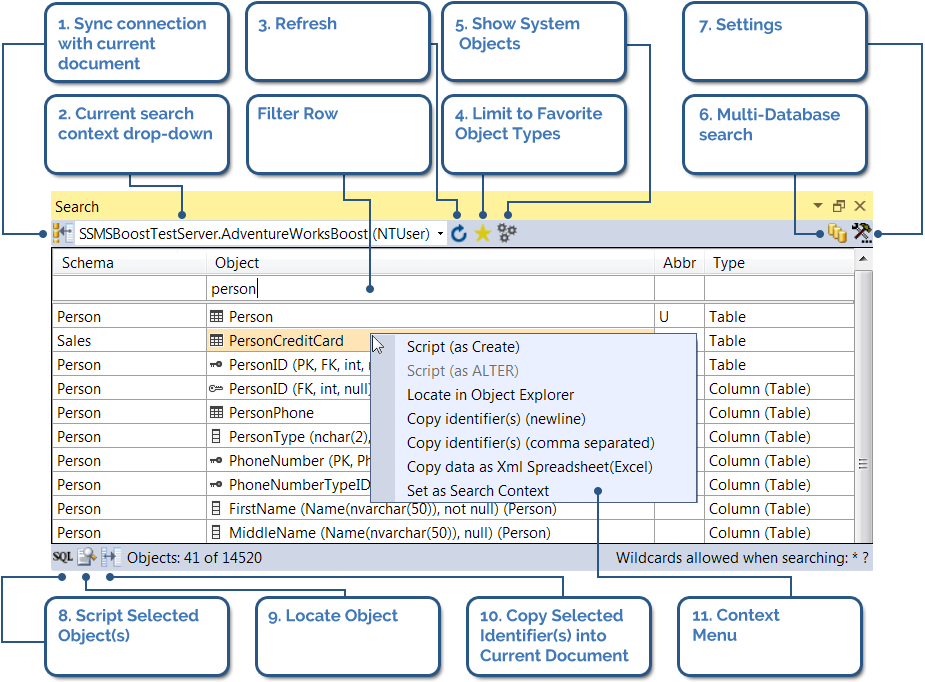
Search for Object by Token
SSMSBoost offers a very powerful search engine that allows you to search for database objects, columns and function parameters across one or multiple connections directly from SSMS user interface. Search for Object by Token is a feature that makes search objects search function even more convenient. To use it place cursor on the object or column and hit SHIFT+F2.
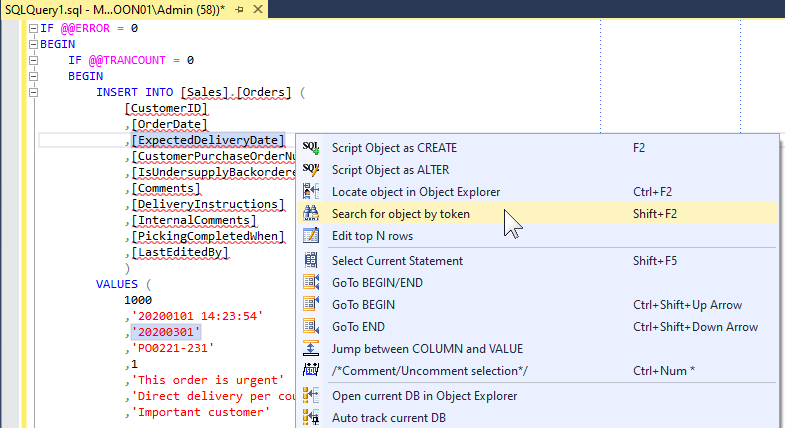
This tool immediately sets current text string under cursor as filter string in the Object Search dialog.

This can help you find all objects containing particular column, or objects containing some particular string in their name. This might be helpful, for example, when you want to find all occurrences of some column across all database objects.
Select Current Statement / Run current statement
We have received a lot of requests from our users to implement "Run current SQL statement" functionality, as finding and selecting the boundaries of the current SQL Statement to perform "Run selected statement" is very time-consuming and requires several keyboard strokes and mouse clicks.
We have implemented "Select Current Statement" (SHIFT+F5) feature which, followed by "Execute (F5)", gives you the desired "Run current statement" functionality in SSMS Query Editor.
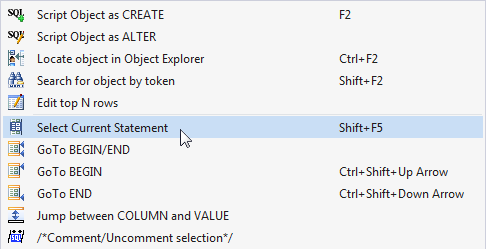
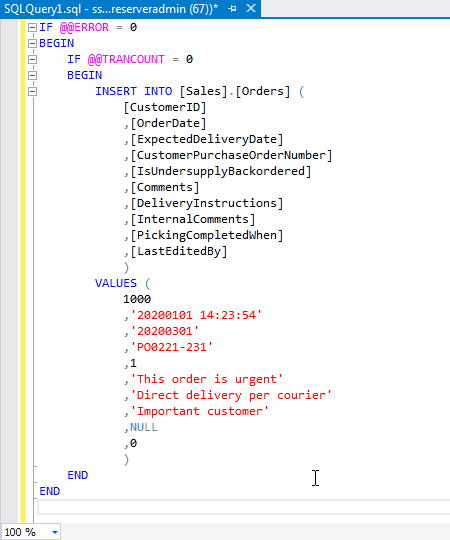
We did not implement a one-click "Run current statement" command for security reasons - to save you from fatal errors. You have the last chance to review statement boundaries that have automatically been detected by parser before hitting "F5".
Jump between matching BEGIN/END tokens
This function allows you to jump to BEGIN or END of the current block or jump between corresponding BEGIN/END tokens. To activate this function select the corresponding command in SQL Editor context menu.
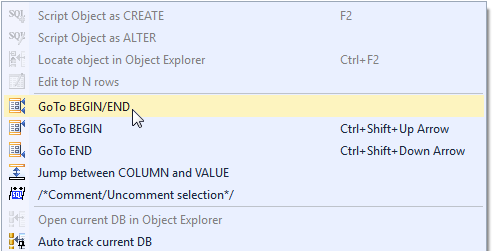
You can also use universal "JUMP" shortcuts Ctrl+Shift+Up Arrow to navigate "UP" (to BEGIN) or Ctrl+Shift+Down Arrow to navigate "Down" (to END). For better visibility the corresponding BEGIN/END pairs are highlighted.
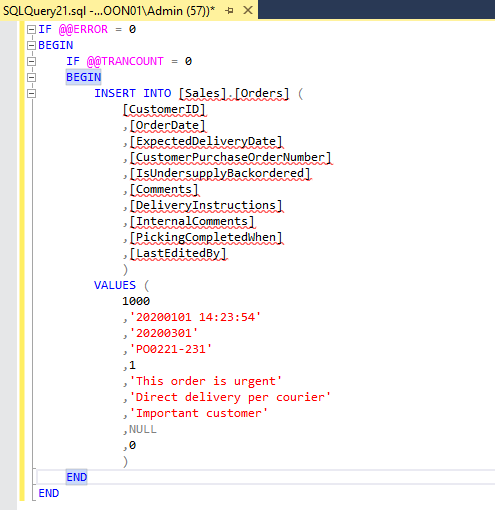
These shortcuts are shared with Jump between COLUMN/VALUE within INSERT statement functionality and act depending on the current cursor position.
Jump between brackets ()
Quick matching of values within brackets is a very convenient time-saving feature. With SSMSBoost jump between bracket pairs is performed with hotkeys: CTRL+SHIFT+UP is used to move the cursor leftwards to the opening bracket and CTRL+SHIFT+DOWN moves the cursor rightwards to the closing bracket.
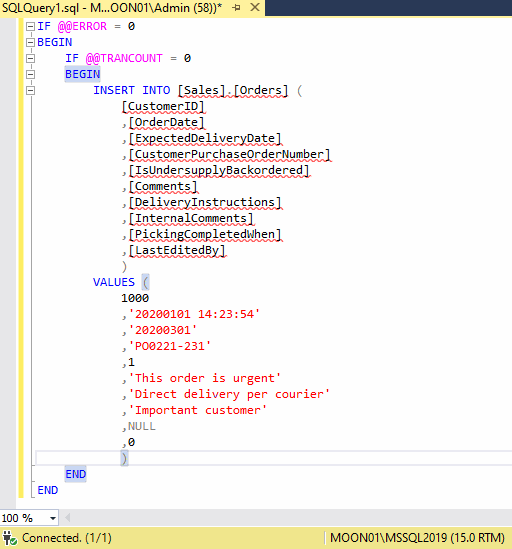
Note that the same hotkeys can now be used to jump between matching BEGIN/END tokens and between COLUMN/VALUE within INSERT statement
Jump between COLUMN/VALUE within INSERT statement
When editing large INSERT statements with big number of columns involved it is useful to know the corresponding COLUMN of the currently edited VALUE. And vice versa: sometimes you want to locate the corresponding VALUE within values list for the current COLUMN. The solution is to use "Jump between COLUMN and VALUE" command in SQL Editor context menu.
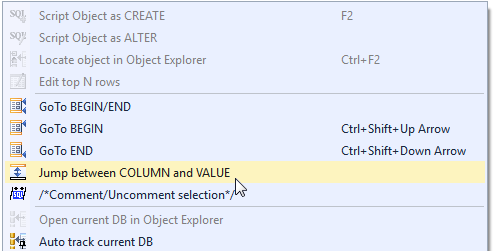
You can also use universal "JUMP" shortcutsCtrl+Shift+Up Arrow to navigate "UP" (from VALUE to COLUMN) orCtrl+Shift+Down Arrow to navigate "Down" (from COLUMN to VALUE). For better visibility the corresponding COLUMN/VALUE pairs are highlighted
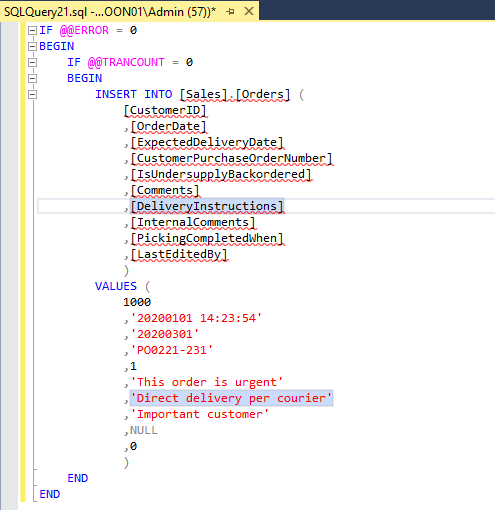
These shortcuts are shared with GoTo BEGIN/END functionality and act depending on the current cursor placement.
Comment/Uncomment selection
SSMS has a standard feature that allows you to comment selected text, however, it uses "--" syntax, thus making it impossible to insert comments within the line. SSMSBoost added a smart /*comment selection*/ feature which does exactly what developers expect it to do: it puts /**/ marks at both sides of the selected text:
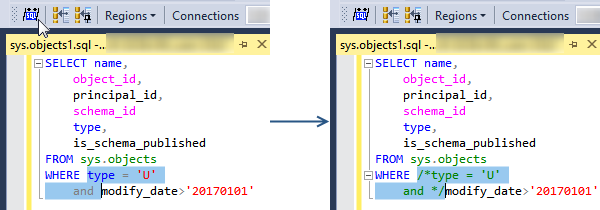
This feature can also be used to remove comments when a selection perfectly matches comment bounds (works with both /**/ and -- syntax):
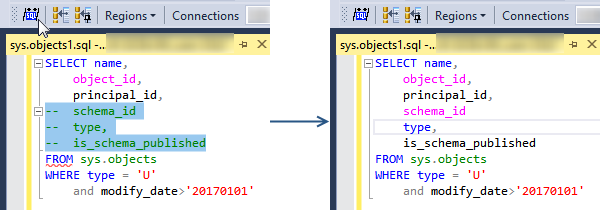
To comment any selected statement in just one keystroke Press CTRL+* with NumLock enabled:
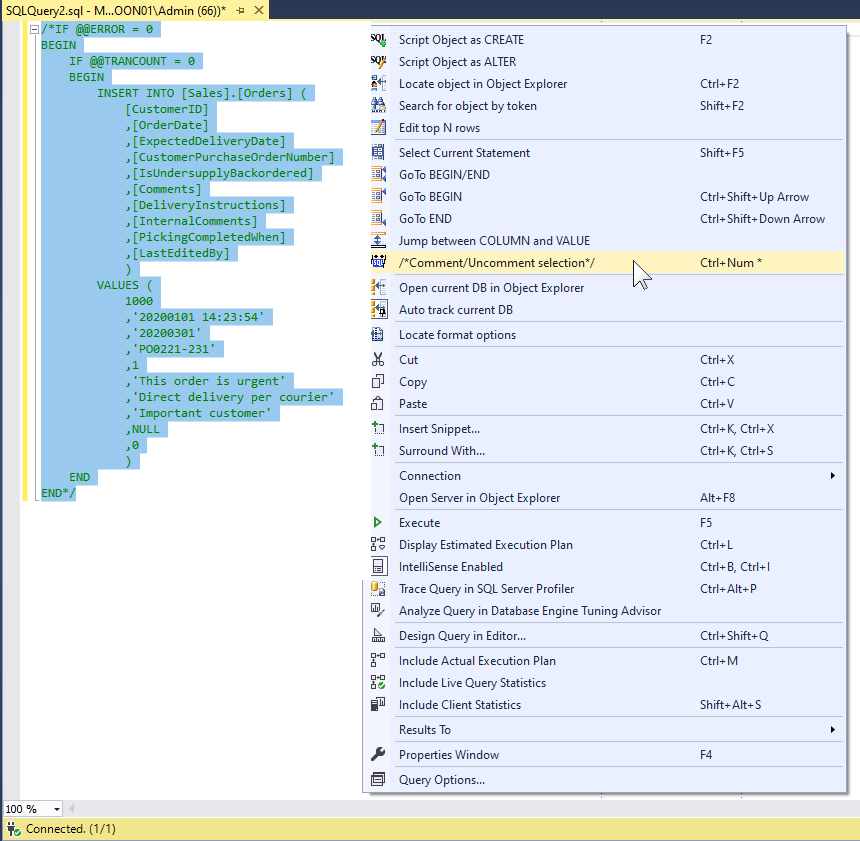
Selected statement will be commented automatically.
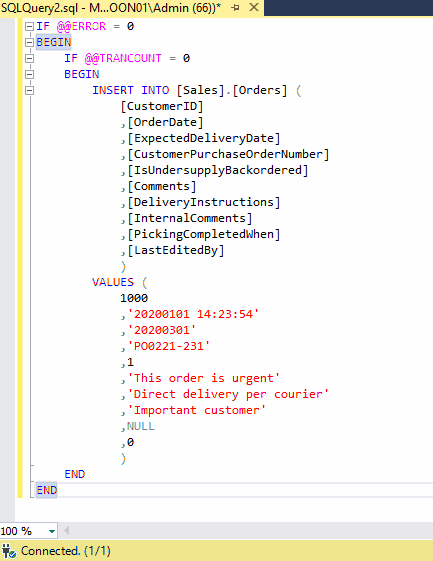
If you select a commented statement the same key combination will uncomment it.
Regions in SQL Server Management Studio !
SSMSBoost adds the possibility to use common regions syntax in SQL Editor:
--#region [Name]
--
0 Response to "Ssms Not Dispaying Line Feed in Result Window"
إرسال تعليق